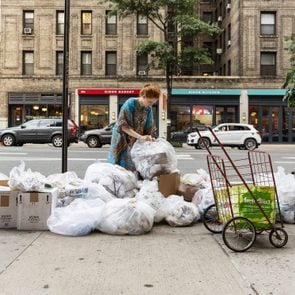What Is Fast Fashion, and How It’s Destroying the Environment
Updated: Oct. 05, 2022
If you're looking to reduce your carbon footprint, adopt a greener lifestyle, or make one small change that has a positive impact, your closet is an easy place to make eco-friendly shopping choices.

Let’s be honest, fast fashion offers a quick thrill: cheap clothes that allow us to quickly refresh our wardrobes and follow the latest trends. However, these same fast-fashion brands have a lot of skeletons in their closets. You know how when something seems too good to be true it usually is? In this case, those low prices are made possible by shortcuts that harm the environment and the people who make the clothes.
While much of the responsibility rests on the shoulders of brands, consumer habits are important too, says Reimer Ivang, founder of Better World Fashion, a Danish sustainable fashion brand. Consumers can stand up to the hazards of fast fashion’s environmental impact by learning to spot fast-fashion brands and opting instead to support sustainable clothing brands that utilize manufacturing processes and materials that are more ethical and better for the Earth. And it isn’t only about what you buy, it’s also about what you do with the clothing when you’re finished with it. You can do good by recycling or upcycling clothes instead of tossing them out.
Before we share tips on how to shop for more sustainable clothing, we’re going to look at just how fast fashion became so bad in the first place.
Exactly what is fast fashion?
That $10 dress or $5 T-shirt you see hanging on a store rack—chances are, that’s fast fashion. The store that restyles its mannequins in new clothes weekly, or a website that updates its offerings daily, that’s fast fashion too. Basically, cheap trendy clothing is fast fashion. The term refers to a business model where manufacturers set up a system to quickly reproduce the latest styles seen on celebrities and runways to sell them to customers for a fraction of the cost of designer lines. Collections like these are produced on a mass scale that encourage a pattern of shopping and discarding items for new outfits at a rapid pace.
| The standard runway business model sees designers creating four to six collections in a year. But fast-fashion retailers can produce 12 to 14 collections in that same time frame! |
How did fast fashion happen?
As recently as the turn of the 20th century, the majority of clothing was tailored to your body, either in a specialty store or made at home by hand. Garments could take weeks to be made. This all began to change as the assembly lines and factories that were the hallmark of the Industrial Revolution slowly became a mainstay of clothing production—and it has stayed that way ever since.
Beginning in the 1960s—when the average American bought fewer than 25 items of clothing per year—fashion began turning over more quickly, and the manufacturing process evolved along with it to keep up with ever-changing tastes. Since then, the pace has only quickened: By some estimates, Americans bought an average of 68 items of clothing per year in 2018. On average, each piece is worn just seven times before being cast aside, according to one study. Where does all that unused clothing go? To the landfill, to the tune of 10.5 million tons of textiles (the majority of it clothing) in 2015, according to the Environmental Protection Agency.
Examples of fast-fashion brands
One of the pioneers of fast fashion is the well-known Spanish brand Zara. Founded in 1975, the retailer made its name making less expensive versions of high-end clothing. This model has been copied by numerous other retailers, including H&M, Shein, Boohoo, Uniqlo, Topshop, Primark, Mango, and more.
How to spot fast-fashion brands
Cheap fashion is made with cheap labor and cheap materials. A few telltale signs to be on the lookout for include:
- Low cost. One of the easiest ways to spot a fast-fashion brand is to look at the prices. If they’re too good to be true, they probably are.
- Synthetic fabrics. While some quality items are made with polyester, rayon, and nylon, fast fashion typically uses these more than natural fabrics such as cotton and silk.
- Poorly done finishing touches. Check seams and buttons. With fast fashion, seams may give away readily and buttons may be loose.
- Rotating inventory. Brands that update their stock weekly or bi-weekly are following the fast-fashion model to keep consumers buying, discarding, and buying more.
Problems with fast fashion

Getting all those new items of clothing into the hands of consumers means that corners are cut when it comes to designing, producing, and shipping.
Environmental impact
One of the cheapest and most popular fabrics is polyester; unfortunately, it comes with a wardrobe-full of problems. For one, it takes nearly 432 million barrels of oil yearly to make synthetic textiles. This reliance on fossil fuels produces greenhouse gas emissions that are linked to climate change. These plastic-based fabrics also pose a threat of shedding microplastics—tiny pieces of plastic that are 8 mm in length—in the washing machine that are then washed into our oceans, where they pollute the oceans and other waterways.
Even natural fabrics are problematic when used by fast-fashion retailers. In 2019 alone, conventional cotton crops grown in the U.S. required 68 million pounds of pesticides. These chemicals don’t just sit on cotton crops, they contaminate soil from runoff water and pose a risk of water and soil contamination for local communities.
Fast fashion doesn’t get much better when it comes to the next stage in the design process—achieving all those beautiful colors. It takes up to 200 tons of water to produce a ton of dyed clothing. Worse still, the conventional dyes used are a mixture of chemicals that don’t break down properly as they enter rivers and oceans. Over the years, these chemicals accumulate in the environment, and in some instances, waterways close to factories where runoff water from the dyeing process enters have become too hazardous to use. One example: In China, a global capital of the clothing manufacturing industry, more than 70 percent of the rivers are contaminated and deemed unsafe for human use. You can do your part to conserve water at home.
The human cost
Cheap clothing is made by cheap labor: Thirty-five cents per hour—that’s the wage for factory workers who produce clothing for some popular retailers.
Sometimes working conditions are unsafe too. The 2013 accident at the Rana Plaza building in Bangladesh highlighted the cost of fast fashion when the building that housed five garment factories collapsed, killing more than 1,000 garment workers. The tragic incident shone a spotlight on the inhumane conditions at the factory, including slave wages, labor rights violations that included 14-hour workdays, physical and verbal abuse, and exposure to toxic chemicals.
Sadly, these issues are still largely unaddressed throughout the fashion industry, and human rights groups are continuing to fight for workers’ rights. One way you can help is to shop for brands that are Fair Trade Certified.
Impact on animals
Animals are harmed by fast-fashion production in a number of ways. The microplastics mentioned above don’t just pollute oceans, they are also harmful to marine life. Sea creatures, from tiny lugworms and shrimp to giant whales, ingest microplastics. While the effects of microplastics on sea life are still being studied, research has shown that in smaller sea animals they can block their digestive tracks and lead to starvation.
Then there are the threats to their habitats. Rayon and viscose are made of wood pulp. Entire forests in Indonesia, Canada, and the Amazon have been logged to create clothing, destroying animal habitats in the process.
Lastly, the most direct impact is to the animals raised and often slaughtered for the materials they produce, such as silk and leather. While there are arguments for avoiding all materials that come from animals, the ones used by fast-fashion manufacturers are particularly egregious. For example, some silkworms are boiled alive so that the silk from their cocoons can be harvested. (Wild silk or peace silk, where the moth leaves its cocoon behind, are considered more humane alternatives.)
Disposable clothing
Most of the clothing created by fast-fashion retailers ultimately ends up in landfills; some estimates suggest that the average American throws away 82 pounds of clothing each year. “Because clothing is cheap and abundant, we wear each piece less and throw it out at higher rates than in the past,” says Karla Magruder, founder of Accelerating Circularity, a group that promotes recyclable fashion. “People in the U.S. throw away approximately 11 to 12 million tons of textiles per year,” she says.
So, what can we do now?

Now that you know what fast fashion is and have a better idea how to spot these brands, you can begin to seek out more sustainable fashion choices. At first, you might be tempted to embrace H&M’s “conscious” line or Boohoo’s latest “sustainable” collection. But, be aware that these usually amount to nothing better than greenwashing. “Many companies use the term [“sustainable”] to show that they’ve changed a small percentage of faulty business models, but they’re far from being a part of the solution,” Ivang says.
Instead, a smarter idea is to look for sustainable brands that have built sustainable manufacturing practices into their business model from the start. That can include sourcing natural or organic fabrics (GOTS-certified is the gold standard) and ensuring that their garment workers are paid a livable wage and have fair working conditions.
Another way to embrace sustainability is to shop less, buy vintage or secondhand, wear items longer, and recycle or upcycle your clothing instead of throwing out old items. Recycling your clothing can have the added benefit of creating materials for brands that repurpose existing fabrics instead of relying on new resources, explains Magruder.
What’s next for fashion?
There are a lot of changes that need to happen to make the industry better for both the environment and the people who make these garments.
A garment’s lifecycle—from the raw materials used to the length of time a garment is worn and how its discarded—is key to creating a better fashion model. “The fashion industry needs to learn how to make fewer, more durable clothes that are made in a way that allows them to be readily recycled,” Magruder says.
As consumers, we don’t have to wait for fast-fashion brands to recycle and create better clothing. We can begin supporting sustainable fashion brands, buying less overall, and upcycling and recycling our clothing. If you’d like to learn more about creative ideas on how to upcycle clothing, read about Ocean Sole, the Kenyan-based group turning discarded flip-flops into beautiful artwork.
Sources:
- Reimer Ivang, founder of Better World Fashion
- Scientific Reports: “Plastic microfibre ingestion by deep-sea organisms”
- CFDA: “Polyester”
- The Organic Center: “The Environmental Footprint of Organic Cotton”
- PNAS: “Citizen monitoring of waterways decreases pollution in China by supporting government action and oversight”
- Fashion Revolution: “The Human Cost of Our Garments”
- Karla Magruder, founder of Accelerating Circularity



